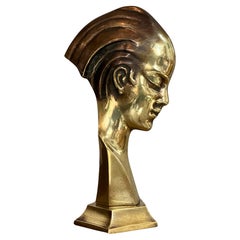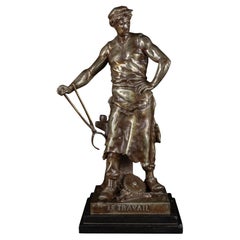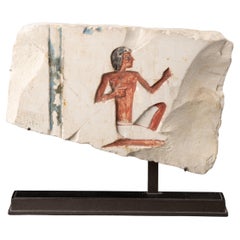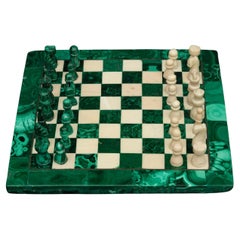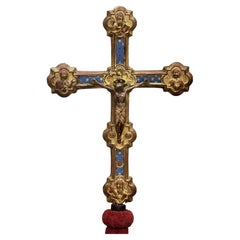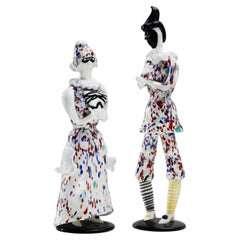Brussels Figurative Sculptures
to
20
84
3
48
12
24
3
4
7
3
2
1
2
1
9
5
3
2
2
2
1
1
1
29
26
21
18
17
7,738
7,607
72
33
18
13
4
Height
to
Width
to
87
84
84
3
3
2
1
1
Item Ships From: Brussels
Art Deco Guido Cacciapuoti Cast Bronze Figurine Sculpture of a Lady
By Guido Cacciapuoti
Located in Torquay, GB
Art Deco cast bronze sculpture of a lady.
Attributed to Guido Cacciapuoti (Italian 1892-1953).
Featuring a stylised striking representation of an elegant yet mysterious lady.
Dual to...
Category
Early 20th Century Art Deco Brussels Figurative Sculptures
Materials
Bronze
Emile Louis Picault (1833-1915) « LE TRAVAIL » bronze statue
By Émile Louis Picault
Located in Ixelles, BE
Emile Louis Picault (1833-1915) « LE TRAVAIL » bronze statue
The bronze statue 'Le Travail' by Émile Louis Picault is much more than a mere work of art. It embodies the very essence...
Category
19th Century French Industrial Antique Brussels Figurative Sculptures
Materials
Bronze
Egyptian Fragment of a Seated Man - Ancient Egypt, 26th Dynasty (664-525 BC)
Located in Bruxelles, BE
Egyptian Fragment of a Seated Man
Limestone - polychromy
Ancient Egypt, 26th Dynasty (664-525 BC)
Most likely from the tomb of Montw-m-H3t
Provenanc...
Category
15th Century and Earlier Egyptian Egyptian Antique Brussels Figurative Sculptures
Materials
Limestone
Small square malachite and marble chessboard
Located in Ixelles, BE
Small square malachite and marble chessboard.
Dive into absolute opulence with our malachite and marble chess set, an undisputed symbol of luxury and refinement.
Each piece, meticu...
Category
20th Century Kenyan Mid-Century Modern Brussels Figurative Sculptures
Materials
Malachite, Marble
Paolo di Giovanni Sogliani - Processional Cross Florence, around 1515
Located in Bruxelles, BE
Paolo di Giovanni Sogliani (Florence 1455-1522)
Processional Cross
Florence, around 1515
Enameled, chiseled, engraved, stippled, and gilded copper; wooden core ; Inscription: "OPA...
Category
16th Century Italian Renaissance Antique Brussels Figurative Sculptures
Materials
Copper, Enamel
Pair of figurines Arlecchino and Arlecchina by Fulvio Bianconi, Venini Murano
By Fulvio Bianconi, Venini
Located in Uccle, BE
Pair of figurines Arlecchino and Arlecchina by Fulvio Bianconi, Venini Murano Italy (Founded in 1921).
The pair of figurines Arlecchino and Arlecchin...
Category
Mid-20th Century Italian Mid-Century Modern Brussels Figurative Sculptures
Materials
Art Glass
Christ - Umbria, second half of the 15th century
Located in Bruxelles, BE
Christ
Umbria, Orvieto?
Second half of the 15th century
77 x 16.5 cm
Category
15th Century and Earlier Italian Renaissance Antique Brussels Figurative Sculptures
Materials
Walnut
Small round chess board in malachite and marble
Located in Ixelles, BE
Small round chess board in malachite and marble.
Immerse yourself in absolute opulence with our malachite and marble chess set, an undisputed symbol of luxury and refinement.
Each...
Category
20th Century Kenyan Mid-Century Modern Brussels Figurative Sculptures
Materials
Malachite, Marble
Louis Thomas Jérôme Auzoux (1797-1880) - Skinned, Human anatomical Model
By Dr. Louis Auzoux
Located in Bruxelles, BE
Louis Thomas Jérôme Auzoux (1797-1880)
Skinned
Human anatomical Model
Paris, around 1850
135 cm
In the 1820s Louis Auzoux, a French medical graduate ...
Category
Mid-19th Century French Other Antique Brussels Figurative Sculptures
Materials
Paper
$19,170 Sale Price
20% Off
Large Art Deco French Woman with a Swan, France 1930:40s, Plaster with Patina
By Auguste Rodin
Located in Forest, BE
Large chimney Art Deco plaster. The base is black lacquered with extensive patina. The woman is laying with a swan and a bowl. The were originally white painted but now it is more li...
Category
Early 20th Century French Art Deco Brussels Figurative Sculptures
Materials
Plaster
$599 Sale Price
50% Off
Miguel Berrocal ( 1933-2006) " Richelieu" , Signed and Numbered
By Miguel Berrocal
Located in Brussels, BE
Miguel Berrocal ( 1933-2006) " Richelieu" , Signed and Numbered
Category
20th Century Brussels Figurative Sculptures
Materials
Brass
Sculpture representing the “deconstructed” Statue of Liberty by Arman
By Arman
Located in Uccle, BE
Sculpture representing the “deconstructed” Statue of Liberty by Arman (Armand Fernandez).
Bronze with blue-grey patina and polished bronze.
The Statue of Liberty is a recurring motif...
Category
Mid-20th Century French Mid-Century Modern Brussels Figurative Sculptures
Materials
Bronze
Corbel with an Angel Holding a Shield
- Burgundian Netherlands 15th century
Located in Bruxelles, BE
Corbel with an Angel Holding a Shield
Franco-Flemish, Burgundian Netherlands 15th century
Limestone
On a modern metal stand
H 21 x L 16,5 x P 18,5 cm
This finely carved stone corbel,...
Category
15th Century and Earlier Belgian Gothic Antique Brussels Figurative Sculptures
Materials
Limestone
French Woman Torso in white painted clay, France 1960's, Nude
By Auguste Rodin
Located in Forest, BE
Torso of a nude women in white painted clay. It's a brutal textured with pattern and traces when it was made. White painted on top of the clay.
The pedestal is also available on another advertisement.
_______________________________________________________
L'étude et la représentation artistique du corps humain a été constante dans toute l'histoire de l'art, depuis la préhistoire (le Vénus de Willendorf) jusqu'à nos jours.
Une des cultures où la représentation artistique du nu a le plus proliféré a été dans la Grèce Antique...
Category
Early 20th Century French Brutalist Brussels Figurative Sculptures
Materials
Clay
Jef Lambeaux (1852-1908) “THE SOWER”
By Jef Lambeaux
Located in Ixelles, BE
Jef Lambeaux (1852-1908) “THE SOWER”
Artistic Description:
"The Sower" depicts a vigorous young man, bare-chested, in the act of sowing seeds. The sculpture captures with precision...
Category
Late 19th Century Belgian Art Nouveau Antique Brussels Figurative Sculptures
Materials
Bronze
Gothic Canopy, France, 15th Century
Located in Bruxelles, BE
Gothic canopy
France, 15th century
Alabaster, some traces of polychromy
33 x 23 x 20 cm
Provenance:
- Private collection Genève, Switzerland
...
Category
15th Century and Earlier French Gothic Antique Brussels Figurative Sculptures
Materials
Alabaster
$23,962 Sale Price
20% Off
Terracotta Bust of Christ as the Redeemer, 15th Century
Located in Bruxelles, BE
A terracotta bust of Christ as The Redeemer
Tuscany or Emilia Romagna, late 15th century
Measures: 46 x 43 x 21 cm
This powerful, moving bust of...
Category
15th Century and Earlier Italian Renaissance Antique Brussels Figurative Sculptures
Materials
Terracotta
$17,253 Sale Price
20% Off
Pendant by Novello Finotti, Italy
By Novello Finotti
Located in Brussels, BE
Pendant by Novello Finotti, Italy.
Category
1970s Vintage Brussels Figurative Sculptures
Materials
Gold, Silver, Bronze
Bronze Sculpture " Cowboy on his horse" by Paul Sersté, Belgium
By Paul Serste
Located in Brussels, BE
Bronze Sculpture " Cowboy on his horse" by Paul Sersté, Belgium
Category
20th Century Belgian Brussels Figurative Sculptures
Materials
Bronze
19th Century Polychrome Wooden Horse
Located in Brussels, Brussels
Elegant little carved wooden horse from the 19th century in polychrome wood
Very beautiful polychromy which has a lot of charm
Old child's toy with the front wheels which moves
...
Category
19th Century British Aesthetic Movement Antique Brussels Figurative Sculptures
Materials
Fruitwood
Brighella Monumental Murano glass figurine by Fulvio Bianconi
By Venini, Fulvio Bianconi
Located in Uccle, BE
“Brighella”, Monumental Murano glass figurine by Fulvio Bianconi.
“Lattimo” glass figurine with polychrome decoration.
Represents a slender character dressed in a costume adorned wit...
Category
Mid-20th Century Italian Mid-Century Modern Brussels Figurative Sculptures
Materials
Art Glass, Blown Glass
Giangurgolo Monumental Murano glass figurine by Fulvio Bianconi
By Venini, Fulvio Bianconi
Located in Uccle, BE
“Giangurgolo”, Monumental Murano glass figurine by Fulvio Bianconi.
“Lattimo” glass figurine with polychrome decoration.
Represents a slender character playing the accordion. The cha...
Category
Mid-20th Century Italian Mid-Century Modern Brussels Figurative Sculptures
Materials
Art Glass, Blown Glass
Renaissance Winged Cherub Relief
- Florence, 15th century
Located in Bruxelles, BE
Renaissance Winged Cherub Relief
Florence, Second Half of the 15th Century
Stone with traces of polychromy
Provenance: Important private collection, Northern Italy
This exceptional...
Category
15th Century and Earlier Italian Renaissance Antique Brussels Figurative Sculptures
Materials
Stone
Venus Pudica (Medici-type) - 18th century, Italy
Located in Bruxelles, BE
Monumental sculpture representing the Venus Pudica (Medici-type)
18th Century
Italian (Rome)
White marble
Based on a model from Antiquity, the Medici Venus, currently in the Uffizi ...
Category
Early 18th Century Italian Grand Tour Antique Brussels Figurative Sculptures
Materials
Marble
Fra Mattia Della Robbia, Saint Joseph, Tuscany, Around 1505-1510
By Della Robbia
Located in Bruxelles, BE
Fra Mattia Della Robbia (Firenze 1468-1534)
Saint Joseph
Terracotta
Tuscany, around 1505-1510
55 x 40 x 30 cm
Marco della Robbia the Younger (April 6, 1468 in Florence - 15...
Category
16th Century Italian Renaissance Antique Brussels Figurative Sculptures
Materials
Terracotta
« La Baigneuse » ou « La Nymphe prenant son bain » (1757)
By Étienne Maurice Falconet
Located in Ixelles, BE
Étienne-Maurice Falconet (1716-1791), "The Bather" or "The Nymph Bathing" (1757)
Artistic Explanation:
The Nymph Bathing is a masterpiece of 18th-century French sculpture, created...
Category
1750s French Baroque Antique Brussels Figurative Sculptures
Materials
Bronze
Head of a crowned Virgin - Lorraine, first half of 14th century
Located in Bruxelles, BE
Head of a crowned Virgin
Lorraine, first half of 14th century.
H26 x 14 x 14 cm
Provenance :
- Private Collection, Paris France (1960)
Private Collection Tuscany, Italy (1980)
Ex...
Category
15th Century and Earlier French Gothic Antique Brussels Figurative Sculptures
Materials
Limestone
JEF LAMBEAUX (1852 – 1908) Bronze Statue "THE DANCER WITH CASTANETS"
By Jef Lambeaux
Located in Ixelles, BE
JEF LAMBEAUX (1852 – 1908) Bronze Statue "THE DANCER WITH CASTANETS" .
Imagine a sculpture that transcends mere representation to capture the very essence of movement and passion. "...
Category
19th Century Belgian Art Nouveau Antique Brussels Figurative Sculptures
Materials
Bronze
"The Dying Gaul": Bronze sculpture 'Gala Morente' cast by CHIURAZZI NAPOLI
Located in Ixelles, BE
The Dying Gaul.
- Description of the Work:
A Celtic warrior lies nude, half-reclining on his shield, his body contorted by pain. His right hand touches the ground while his face, m...
Category
19th Century Hellenistic Antique Brussels Figurative Sculptures
Materials
Bronze
Marble Masterpiece: For Connoisseurs of Refinement
Located in Ixelles, BE
Marble Masterpiece: For Connoisseurs of Refinement.
Dive into the exclusivity of chess with our black zebra marble and white set, a stunning fusion of luxury and contemporary design...
Category
Early 20th Century Pakistani Mid-Century Modern Brussels Figurative Sculptures
Materials
Marble
Attributed to GUSTAVE LOUIS BUCHET (1888-1963) Bronze statue "L'EFFORT"
By Gustave Buchet
Located in Ixelles, BE
Attributed to GUSTAVE LOUIS BUCHET (1888-1963) Bronze statue "L'EFFORT" or "L'ATHLETE".
Description of the work The statue "L'EFFORT" or "THE MAN LIFTING A STONE" Attributed to Gust...
Category
20th Century Swiss Art Deco Brussels Figurative Sculptures
Materials
Bronze
Bacchus - Southern Italy, late 17th century
Located in Bruxelles, BE
Bacchus
Southern Italy, late 17th century
Alabaster Sculpture
H: 20 cm
A finely carved 17th-century alabaster sculpture of a naked Bacchus. This Italian alabaster figure depicts ...
Category
17th Century Italian Baroque Antique Brussels Figurative Sculptures
Materials
Alabaster
Louis-Ernest Barrias (1841-1905) Bronze Bas-Relief "The Reader"
By Susse Freres, Louis Ernest Barrias
Located in Ixelles, BE
Louis-Ernest Barrias (1841-1905) Bronze Bas-Relief "The Reader".
Bas-Relief: "The Reader" is a bas-relief created by Louis-Ernest Barrias, a renowned 19th-century sculptor. The bas-...
Category
19th Century French Neoclassical Antique Brussels Figurative Sculptures
Materials
Bronze
Massive Nickeled Resin Skull Signed Y.D., Belgium, 1989
Located in Brussels, BE
Heavy resin skull, nickel -plated.
Signed and dated Y.D.89 at the base.
Category
1980s Belgian Mid-Century Modern Vintage Brussels Figurative Sculptures
Materials
Resin
$1,389 Sale Price
20% Off
Circle of Pierpaolo and Jacobello Dalle Masegne (Venice, late 14th century)
Located in Bruxelles, BE
Circle of Pierpaolo and Jacobello Dalle Masegne (Venice, late 14th century)
San Bartolomeo
high relief 'en applique'
white marble
52 x 30 x 14 cm
Provenance :
Collection South of...
Category
15th Century and Earlier Italian Gothic Antique Brussels Figurative Sculptures
Materials
Marble
Large Bronze Monk, 18th Century, Ayuttheya Period, Thailand
Located in Brussels, Brussels
Rare Monk of the 18th century-Ayutthaya-Thailand
Superb large lacquered and gilded bronze monks of large size
Very beautiful face
In superb condition an...
Category
18th Century Thai Other Antique Brussels Figurative Sculptures
Materials
Mahogany
Large Terracotta Relief - Lombardy, First Half of 17th Century
Located in Bruxelles, BE
Large Terracotta relief of the flight into Egypt
Lombardy, first half of 17th century
Painted terracotta
91 x 85 x 11,5 cm
This event in the early life of Christ is recounted i...
Category
17th Century Italian Baroque Antique Brussels Figurative Sculptures
Materials
Terracotta
$62,303 Sale Price
20% Off
Rare Romanesque Capital Depicting Four Africans, Apulia, 13th Century
Located in Bruxelles, BE
Large stone capital carved on each side in strong relief. The basket is covered with two crowns of vertical acanthus leaves which sprout from the astragal and fill the space between ...
Category
15th Century and Earlier Italian Medieval Antique Brussels Figurative Sculptures
Materials
Stone
$22,045 Sale Price
20% Off
renaissance wooden candelabrum and painted cross - Umbria, 16th century
Located in Bruxelles, BE
Base of a carved wooden candelabrum, polychrome and gilded; cross painted on both sides.
Umbria or Tuscany, 16th century
136 x 43,5 x 30 cm
(The cross and the base of the candelabrum were later assembled)
The base of the candelabrum is intricately carved and adorned with polychrome and gilded finishes. The shafts take on the shape of balusters reminiscent of ancient columns, feature ornate foliage decorations, garlands and winged cherub faces. The feet are crafted in the likeness of lion paws. The base is further embellished with depictions of four saint martyrs, among them Saint Barbara and Saint Catherine of Alexandria. The plasticity of the figures, outlined with strong contour lines, the clear and vibrant colors, are stylistic elements linked to the Umbrian tradition of the sixteenth century.The precisely defined and elegant drawing, along with the clear color palette applied with refined chiaroscuro modulations, became the signature of a style that would leave a lasting mark on the era to come. This is exemplified by a preference for vibrant, multicolored images, accentuated in this case by the use of red and pink in the saint's attire.
A notable addition, introduced later, is a polylobed cross painted on both sides. On one side, the Crucifixion is vividly portrayed:The treatment of the corpus itself is in line with High Medieval practice, emphasizing pathos by showing Jesus dead, his arms sagging from the weight of the body. The upper section displaying a pelican pecks at her breast to feed her young with her own blood; a symbol of the sacrifice of Christ on the cross whose body and blood similarly nourishes the celebrant during Mass.
The lower part depicts Golgotha. On the reverse side, the Resurrection is artistically presented in a Renaissance iconography, reminiscent of the renowned composition painted by Piero della Francesca, now housed in the Civic Museum of Sansepolcro. In terms of composition, with the frontal depiction of Christ holding the banner, this motif became particularly widespread in central Italy, spanning from Tuscany to Umbria throughout the 16th century..
The double-sided construction suggests that it may also have been carried in liturgical processions. In Umbria from the 14th century, the use of portable crosses painted on both sides had become a widespread practice, aimed at satisfying the monastic clientele that had significantly increased following the establishment of new religious communities.
The earliest surviving Tuscan painted crucifix represent Christ as Christus Triumphans, or the “Triumphant Christ” with his head up and eyes open. This form was supplanted in the 13th century with the Christus Patiens, or “Suffering Christ” type who is shown often with his head fallen on his shoulder and his eyes closed, as In our cross. The iconography of the suffering Christ appears to have developed out of a new interest in Christ’s human nature, the development of the feast of Corpus Christi and with increased importance given to the Eucharist. The process of humanizing the figure of Christ reaches its peak with the abandonment of all the previous expressive conventions in favor of more realistic details we can observe in this Crucifix, such as the swollen belly, the arms stretched to the limit of muscle tearing, the body falling heavily forward, the abundant blood on
the wounds, and the cross firmly embedded in the rock of Calvary.
It's worth noting that Renaissance candelabra...
Category
16th Century Italian Renaissance Antique Brussels Figurative Sculptures
Materials
Wood, Giltwood
Wood Sculpture, 1950s
Located in Brussels, BE
Wood sculpture, 1950s.
Category
1950s Vintage Brussels Figurative Sculptures
Materials
Wood
$2,246
Renaissance Marble Portrait - Northern Italy, 17th century
Located in Bruxelles, BE
Renaissance Marble Portrait
Northern Italy, 17th century, inspired by antiquity
Marble
36 x 13 cm (including the marble pedestal)
This Renaissance portrait head of a young man, sl...
Category
17th Century Italian Renaissance Antique Brussels Figurative Sculptures
Materials
Marble
$9,585 Sale Price
20% Off
Agnolo di Polo Firenze 1470 - Arezzo 1528' - Saint Nicholas of Tolentino
Located in Bruxelles, BE
Agnolo di Polo (Firenze 1470 - Arezzo 1528)
Saint Nicholas of Tolentino
Around 1510-1520
Painted and gilded terracotta
55.5 x 24 x 16.5 cm
San Nicholas de Tolentino is represe...
Category
16th Century Italian Renaissance Antique Brussels Figurative Sculptures
Materials
Terracotta
$15,336 Sale Price
20% Off
Gothic crowned Head - Île de France, 14th century
Located in Bruxelles, BE
Head of a crowned Virgin
Île-de-France, first half of 14th century.
H26 x 14 x 14 cm
Provenance :
- Private Collection, Paris France (1960)
- Private Collection Tuscany, Italy (19...
Category
15th Century and Earlier French Gothic Antique Brussels Figurative Sculptures
Materials
Stone
Two rare Figures in Turkish Attire - Venice, early 17th century
Located in Bruxelles, BE
Rare Bronzes Depicting two Figures in Turkish Attire
Possibly Suleiman the Magnificent at two different ages
bronzes, alabaster bases
Venice, early 17th century
19,5 x 6 x 5 cm
These two rare bronze statuettes represent two figures dressed in elaborate "Turkish" attire. They are mounted on alabaster bases with bronze reliefs—one featuring the winged lion of Venice, and the other possibly symbolizing Turkey with a wolf depiction.
One figure wears a grand külah, a spherical turban with a cone top, signifying royal authority, while the other has a wrapped turban, denoting rank and religious identity. Their garments are richly detailed with intricate engravings, suggesting luxurious fabrics of the Ottoman court.
The statuettes may represent Suleiman the Magnificent at two different stages of life, as both young and old. The sultan depicted alongside the winged lion corresponds to a description from a Venetian delegate in 1534, when Suleiman was 43. At that time, he had conquered Iraq from the Safavids and achieved a decisive victory over the Papal fleet at the Battle of Preveza. He was described as having large eyes, an aquiline nose, and long red mustaches—traits visible in Cristofano dell'Altissimo’s portrait of Suleiman in the Uffizi Gallery in Florence.
Unlike Mehmed II, who commissioned portraits by European artists for diplomatic purposes, Suleiman did not directly order such representations. Instead, his likeness spread through works by artists like Albrecht Dürer, based on sketches made by diplomats. Following his capture of Belgrade in 1521, his victory over Hungary in 1526, and his siege of Vienna...
Category
17th Century Italian Renaissance Antique Brussels Figurative Sculptures
Materials
Alabaster, Bronze
Butter Plate by Marta Bonilla
Located in Geneve, CH
Butter plate by Marta Bonilla
Dimensions: D9 x H9 cm
Materials: Metal
Butter plate: Piece modelled by hand, enamelled with matte white enamel and ...
Category
2010s Belgian Post-Modern Brussels Figurative Sculptures
Materials
Metal
$316 / item
16h century Griffin Head - Italy
Located in Bruxelles, BE
Griffin head
Italy, 16th century
On a modern metal stand
Measures: 20 x 29 x 21 cm (without the stand)
The griffin is a legendary creature with the body of a lion, the head an...
Category
16th Century Italian Renaissance Antique Brussels Figurative Sculptures
Materials
Marble
$4,193 Sale Price
30% Off
Cerberus, Italy, 17th Century
Located in Bruxelles, BE
Cerberus
Black painted stone
Italy, 17th century
Measures: 80 x 69 x 36cm
(one head missing)
Cerberus, cruel monster, fierce and strange,
Through his wide threefold throat barks as a dog
Over the multitude immers'd beneath.
His eyes glare crimson, black his unctuous beard,
His belly large, and claw'd the hands, with which
He tears the spirits, flays them, and their limbs
Piecemeal disparts (Dante, Inferno, Canto VI).
Cerberus figure seated, in his role of ferocious guardian of the underworld; he shows a nervous musculature, an adherent skin which reveals the ribs, long and robust limbs; his heads are broad and the eyes set well apart.
Painted in black to amplify his menacing look, the infernal guardian is depicted with his famous attributes, writhing his heads, growling and barking furiously.
Cerberus, in Greek mythology, was the monstrous watchdog of the underworld – also known as the “hound of Hades” – preventing the dead from leaving, and making sure that those who entered never left.
A child of Typhon and Echidna, he was part of a monstrous family, which included Orthus, the Lernaean Hydra, and the Chimaera as well. Only on three occasions Cerberus was tricked by visitors of Hades: Heracles did it with his strength, Orpheus with his music.
In "The Inferno", Dante places Cerberus as the guardian of the third circle of Hell. With his three mouths, Dante saw Cerberus as a beast that was synonymous with the sin of Gluttony. Virgil gets past the monster by throwing mud in his three mouths, temporarily choking him.
Very rare are the representations of Cerberus in ancient statuary...
Category
17th Century Italian Renaissance Antique Brussels Figurative Sculptures
Materials
Stone
$19,769 Sale Price
25% Off
Marble Lion, Périgord, 17th Century
Located in Bruxelles, BE
Marble lion
white marble
France, probably Périgord, 17th century
Small marble lion wearing a coat of arms pendant with the engraved date, ...
Category
17th Century French Renaissance Antique Brussels Figurative Sculptures
Materials
Marble
$4,942 Sale Price
25% Off
Circular Marble Chess Set: A Melody of Beige and Terracotta Brown
Located in Ixelles, BE
Circular Marble Chess Set: A Melody of Beige and Terracotta Brown.
Discover this magnificent chess set, a true work of art designed to delight both discerning collectors and passion...
Category
20th Century Pakistani Mid-Century Modern Brussels Figurative Sculptures
Materials
Marble
Group Of 5 Earthenware Musician Cherubs, Late 19th, Early 20th.
Located in Brussels, BE
Group Of 5 Earthenware Musician Cherubs, Late 19th, Early 20th.
Category
Late 19th Century European Rococo Revival Antique Brussels Figurative Sculptures
Materials
Earthenware
Handle in the Shape of a Devil’s Head - France, 19th century
Located in Bruxelles, BE
Handle in the Shape of a Devil’s Head
Patinated bronze
France, 19th century
10 x 7,5 x 9 cm
This unusual bronze handle takes the expressive form of a devil’s head, with exaggerate...
Category
Early 19th Century French Other Antique Brussels Figurative Sculptures
Materials
Bronze
Saint John the Baptist
- After a model by Bertoldo di Giovanni
Located in Bruxelles, BE
Saint John the Baptist
Bronze
After a model by Bertoldo di Giovanni (ca. 1440–1491)
Northern Italy, 18th century
27,5 x 8 x 5 cm
This finely cast and patinated bronze statuette ...
Category
Late 18th Century Italian Renaissance Antique Brussels Figurative Sculptures
Materials
Bronze
Study of a Satyr - Italy, early 19th century
Located in Bruxelles, BE
Study of a Satyr
Bronze, cast using the lost-wax (cire perdue) method
Italy, early 19th century
14 x 7 x 10 cm
This evocative bronze sculpture represents a satyr, the half-human, h...
Category
Early 19th Century Italian Modern Antique Brussels Figurative Sculptures
Materials
Bronze
Cercle of Juan Martinez Montañés '1568-1649', Infant St John the Baptist
Located in Bruxelles, BE
Cercle of Juan Martinez Montañés (1568-1649)
Infant St John the Baptist
Spanish, 17th century
H 74 cm
Saint John the Baptist is here represented naked, sitting on a rock, with...
Category
17th Century Spanish Renaissance Antique Brussels Figurative Sculptures
Materials
Wood
Pair Of Saint Mark In Walnut - 16th Century - Venice
Located in Brussels, Brussels
lovely pair of Saint Mark in walnut from the 16th century - Venice
Very beautiful pair finely carved representing Saint Mark with a book in his hand a lion at his side
This is a pen...
Category
16th Century Italian Renaissance Antique Brussels Figurative Sculptures
Materials
Walnut
Altarpiece Representing The Annunciation, North of Portugal, circa 1600
Located in Brussels, Brussels
Exceptional altarpiece representing the annunciation circa 1600, fruitwood
rare altarpiece from the North of Portugal, unique due to its large size representing the scene of the annunciation, where the Archangel Gabriel (represented on the bottom left), sent by god (represented on the top left) announces to Marie (bottom right) that she will give birth to Jesus.
Very good state of conservation, carved on three panels
Dimension: Height 1m51
Width 1m03
Very nice colour and exceptional dimensions
Restorations of use
We placed the altarpiece on a red velvet base and a Spanish occasional...
Category
17th Century Portuguese Renaissance Antique Brussels Figurative Sculptures
Materials
Fruitwood
19th Century Polychrome Wooden Horse
Located in Brussels, Brussels
Elegant carved wooden horse from the 19th century in polychrome wood from England
Very beautiful movement which has a lot of charm
Beautiful patina
The dimensions include the bo...
Category
19th Century British Victorian Antique Brussels Figurative Sculptures
Materials
Wood
Ecce Homo - Florence, 15th century
Located in Bruxelles, BE
A terracotta bust "Ecce Homo"
Florence, 15th century
53 x 44 x 31 cm
Category
15th Century and Earlier Italian Renaissance Antique Brussels Figurative Sculptures
Materials
Terracotta
Niche In Gilt Wood From The 17th Century
Located in Brussels, Brussels
niche in gilded wood from the 17th century from Italy
Lovely niche with a carved wood in its center from the Italian Renaissance
Beautiful original gild wood
Dimensions excluding ba...
Category
17th Century French Renaissance Antique Brussels Figurative Sculptures
Materials
Wood
Mid-Century Modern Bronze Sculpture
Located in Brussels, BE
Mid-Century Modern Bronze Sculpture
Category
20th Century Brussels Figurative Sculptures
Materials
Bronze
Recently Viewed
View AllMore Ways To Browse
Gerome Bronzes
Knight Statue
Lalique Woman Sculpture
Madonna Statues
Male Archer
Max Le Verrier Fayral
Mercury God Hermes
Psyche And The Butterflies
Hermes Mercury Sculpture
Horseshoe Sculptures
Mac Sculpture
Medusa Bronze Sculpture
Paper Mache Figure
Rosin Murano Glass
Rossi Bronze
Italian Furniture Las Vegas
Mars And Minerva
Ming Sancai
